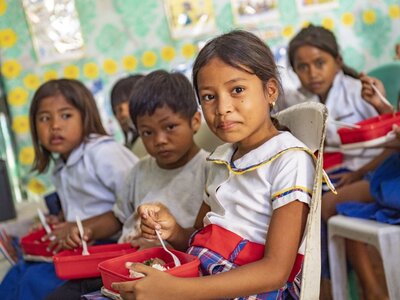The Philippines
- 1st
- in ranking of disaster-prone countries, according to the World Risk Index 2024
- 23.6%
- of children under 5 suffer from stunting
- 114 million
- population
The Philippines is an archipelago of over 7,600 islands. For three consecutive years, it has had the highest disaster risk worldwide , due to its exposure and vulnerability to natural hazards compounded by low coping capacities.
Through sustained post-pandemic recovery efforts, the Philippines is on track towards achieving upper-middle-income status, remaining as one of the fastest-growing economies in Southeast Asia and the Pacific. Amid challenges in achieving Zero Hunger (Sustainable Development Goal (SDG) 2) and Partnerships for the Goals (SDG 17), the country has made moderate progress in 12 of the 17 SDGs.
The Bangsamoro Autonomous Region in Muslim Mindanao (BARMM) saw notable improvements, underscored by a drop in the region’s poverty rate from 60 percent in 2018 to 32 percent in 2023. Within the country, the BARMM remains one of the regions with high poverty and malnutrition rates, due to recurrent natural hazards and conflict-related risks. Cultural norms add further constraints, particularly on women’s livelihood opportunities, with restricted access to basic social services.
The World Food Programme (WFP) has supported the Government in delivering emergency response to natural hazards and armed conflicts, while gradually shifting to capacity strengthening through technical support and augmentation of the disaster risk management capacities of government authorities.
Today, WFP supports the Government in achieving food and nutrition security, by strengthening disaster risk management, social protection, and food systems and capacities to enhance institutional and community resilience.
What the World Food Programme is doing in the Philippines
-
Disaster risk management
-
WFP supports the Government of the Philippines in preparing for and responding to shocks through technical assistance and capacity strengthening, innovative technology, and enhancing humanitarian supply chain management. WFP’s support involves designing and pre-positioning critical response assets and infrastructure, contributing to strengthening the capacity of disaster management professionals at national and local levels, and supporting policy and legislative development. In the event of a sudden-onset emergency, WFP maintains a capacity to provide food or cash assistance to communities as well as emergency logistics and telecommunications support to government responders.
-
Disaster Risk Financing and Anticipatory Action
-
Nutrition and cross-cutting priorities
-
Social protection
-
Climate change adaptation, social cohesion and integrated resilience
Philippines news releases
Go to pagePartners and donors
Find out more about the state of food security in Philippines
Visit the food security analysis pageOperations in Philippines
Contacts
Office
11/F South Tower Rockwell Business Center Sheridan Corner Sheridan and United Streets, Mandaluyong City, Philippines
Manila 1554
Philippines

